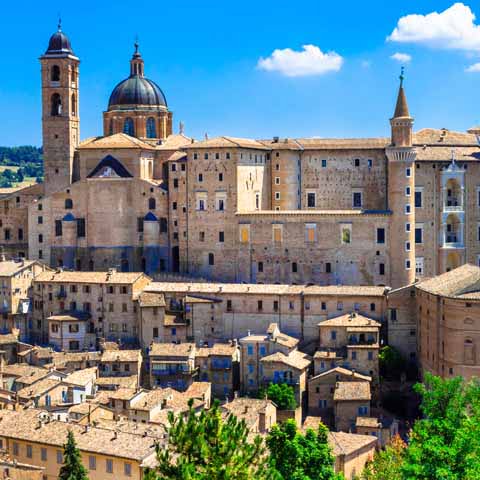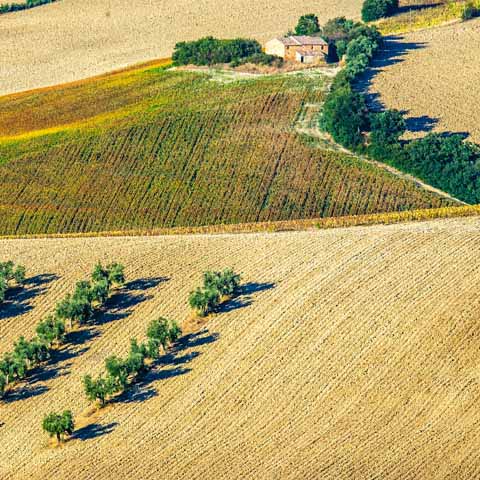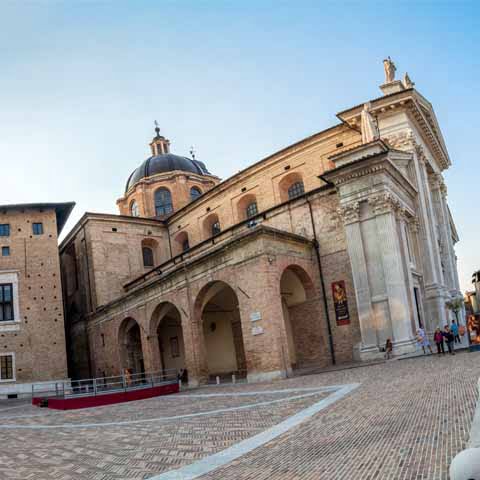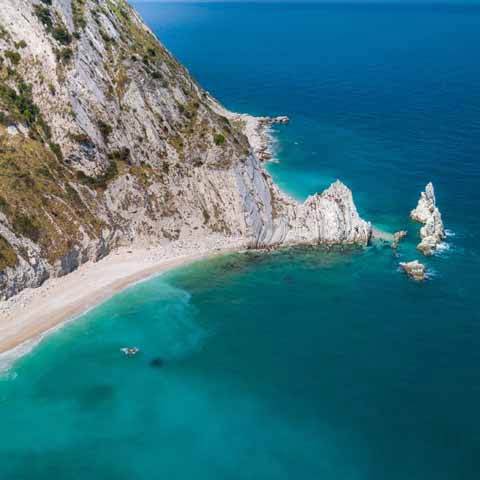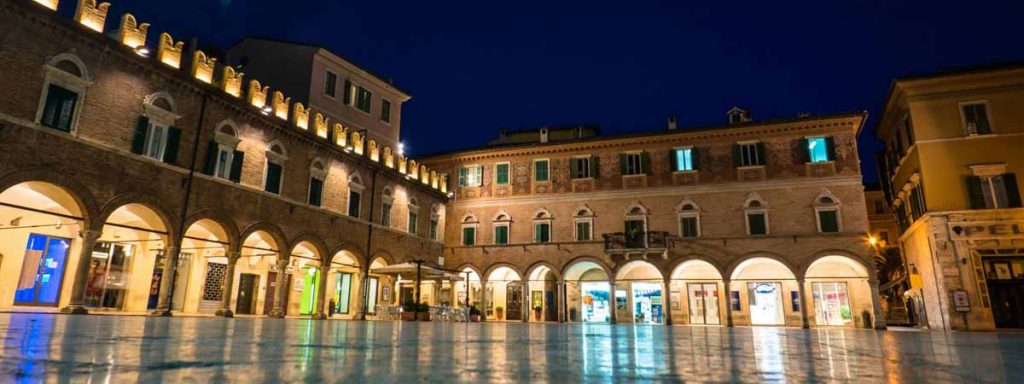During the fifteenth century, Federico da Montefeltro used his status and wealth to attract many incredible artists, creators, and architects of the Renaissance – Giovanni Santi and Piero della Francesca, just to name a few – to Urbino. He stoked the fire of the Renaissance art and architecture movement in Urbino, and the impact of this cultural development was felt throughout Europe.
UNESCO designated the city of Urbino a World Heritage Site in 1998 due to the city’s remarkable historic preservation of Renaissance culture. The organization states that Urbino is a stunning representation of the pinnacle of the Renaissance time period’s artistic and architectural offerings. Even today, culture is palpable throughout the city. Many of the time period’s art and architecture is still present, giving travelers the unique chance to soak up the history of the Renaissance.
ART
Urbino is known for being the birthplace of famed Italian Renaissance artist Raphael. Known specifically for his paintings, Raphael spent his youth in Urbino. Travelers can visit Raphael’s childhood home to get a unique insight into what life was like for this legendary artist.
The house was built in the fifteenth century, and while the door frames still contain original parts, much of the features of the building have since been restored or renovated. Inside, guests can view a collection of paintings, including works such as a painting called l’Annunciazione by Giovanni Santi (Raphael’s father and court painter to the Duke of Montefeltro), and paintings by Raphael himself – la Madonna della Seggiola, Visione di Ezechiele, and a fresco titled Madonna col Bambino, which is believed to be one of Raphael’s earliest works.
In addition to paintings, the house features preserved artifacts including manuscripts, coins, portraits, and more.
Another must-see destination in Urbino for fans of art is the National Gallery of Le Marche, housed inside the massive Ducal Palace. In fact, the museum takes up most of the palace’s rooms, encompassing 80 rooms along the first two floors.
The gallery displays a variety of artwork including paintings, sculptures, frescoes, drawings, engravings, and more unique forms of art such as tapestries and antique furniture. The work contained within the gallery spans the fourteenth to the seventeenth centuries and features legendary artists such as Raphael, Piero della Francesca, Titian, Luca Signorelli, and more.
In addition to the museum, the Ducal Palace is home to the studiolo, a small study once used by Federico da Montefeltro. With walls that feature intricate wood inlays perfectly depicting objects and nature, the studiolo is a true work of art in and of itself.
Also not to be missed is the Oratory of Cinque Piaghe, which was constructed in the seventeenth century. The interior features a papier-mâché crucifixion and ten Baroque paintings that depict the Passion of Christ.
And last, but not least, is the Oratory of San Giovanni Battista, a fourteenth century structure housing important frescoes by Lorenzo and Jacopo Salimbeni.
ARCHITECTURE
Federico da Montefeltro is who travelers must thank for the historic architecture found throughout the city of Urbino. He transformed the city into a cultural hub by using his passion for learning, art, literature, and architecture as the driving force and inspiration behind the construction of the city’s buildings and squares. This passion for culture was translated into the classic design of the buildings and monuments throughout Urbino.
The city’s most important church, the Urbino Cathedral, features unique architectural designs such as a Neoclassical style façade with statues of guardian saints. The light color of the façade is the result of several restorations that took place over the course of many years. Inside the cathedral, travelers can admire masterful frescoes and breathtaking chapels.
An absolute must-see architectural site in Urbino is the Ducal Palace. Built in the fifteenth century by Federico da Montefeltro, it stands as a true symbol of the Renaissance period – one that prioritized beauty, art, and culture. It was crafted by architects such as Maso di Bartolomeo, Luciano Laurana and Francesco di Giorgio Martini, with Laurana being credited as the designer of some of the palace’s most impressive rooms. The palace is characterized by its brick construction and dual towers that soar over Urbino’s city center and are an integral part of Urbino’s unique skyline.
Throughout the city of Urbino, there are a variety of historic churches worth seeing. Many of the churches in the area feature unique architectural elements and rich histories. Some churches travelers may enjoy are the Oratory of San Giovanni, the Oratory of San Giuseppe, the Church and Convent of San Francesco, the Gothic Church of San Domenico, the Church of San Bernardino and many more.
Among these churches, the thirteenth century Church and Convent of San Francesco is considered to be Urbino’s version of the Pantheon due to the important citizens that were laid to rest here including Raphael’s parents and Renaissance painter Federico Barocci. The Church of San Domenico is a fourteenth century church with Gothic elements that was restructured during the eighteenth century.
The Church of Santo Spirito, which dates back to the sixteenth century, is known for its simple, yet elegant façade as well as interior painted ceiling panels. One of the oldest churches in Urbino, the Church of San Sergio, features the ruins of a cistern constructed by the Ancient Romans.
The Church of San Bernardino complex is an excellent example of Renaissance architecture. The structure serves as a mausoleum both for Federico da Montefeltro and his son Guidobaldo, and also features a courtyard and cloister.
Another interesting religious building is the Church and Convent of the Capuchins. The complex dates back to the sixteenth century and was constructed on a scenic hill. Today, the complex is under the jurisdiction of the University of Urbino.
The best way to experience and admire the architecture of Urbino is by walking the classic, narrow city streets. Exploring on foot allows one to see all the historic buildings. Be sure to visit the popular local meeting place, Piazza della Repubblica, which features a large fountain.
As you continue your stroll, keep an eye out for the Oratorio della Morte (Oratory of Death), which dates back to the sixteenth century. The building once served as the seat of the Confraternity of Death, hence its unique name. Inside is beautiful stonework by sculptor Bartolomeo Ammannati as well as the painting Crucifixion by Federico Barocci.
Urbino is also home to one of twelve original obelisks that were brought to Italy from Egypt. Positioned by the Ducal Palace and in front of the Church of San Domenico, it is believed that the obelisk originated from a temple of Isis. It is very similar to the obelisk in Rome’s Piazza Minerva, and was moved to Urbino from Rome during the eighteenth century.
Throughout the city center, travelers have the chance to admire several historic palaces. One example is Della Stacciola Palace, which was constructed during the sixteenth century for a captain associated with the powerful Della Rovere family. The palace changed hands several times and underwent several restorations before serving as Urbino’s Law Court until the 1980s.
Another palace, the Bonaventura Odasi Palace, is the former residence of the Bonaventura and Odasi families. Today, this fourteenth century palace is part of the University of Urbino and is the site of the university’s offices.
For stunning architecture and beautiful art, head to Corboli Palace, which is well known for its frescoes by Antonio Romiti and Francesco Antonio Rondelli.
Travelers should also visit the nineteenth century Albani Palazzo Nuovo. Though it is newer compared to Urbino’s other palaces, this unique construction features humble materials including bricks and tile as well as a façade lined with Doric columns.
Urbino’s most famous native son, Renaissance painter Raphael, is immortalized in a nineteenth century monument by sculptor Luigi Belli. Located in Piano del Monte, the surrounding park also hosts several other busts of illustrious figures that left their mark on Urbino.
Lastly, one of the most easily recognizable structures in Urbino after the Ducal Palace is Fortezza Albornoz, or the Albornoz Fortress. The fortress was originally constructed during the fourteenth century under the orders of Cardinal Egidio Alvarez Carillo de Albornoz. In the early fifteenth century, it was attached to the city walls and afterwards, towers and bastions were added to the structure as well. The area surrounding the fortress has served as a park since the 1970s.
LITERATURE
Much of Urbino’s culture is rooted in academia, given that the town is known for its historic university. The city features a famed Academy of Fine Arts, which is known as a book capital due to the Institute of Book Decoration and Illustration there.
Over the centuries, Urbino has also been the birthplace of several Italian writers including Renaissance poet Battista Malatesta, sixteenth century poet Bernardino Baldi, twentieth century poet and novelist Paolo Volponi (who is the only writer to have won Italy’s prestigious Strega Prize for literature twice), and Nobel Prize for Literature nominee Umberto Piersanti.
CINEMA
Urbino’s scenic architecture translates well to the big screen. In fact, the picturesque Renaissance city has served as the setting for several Italian films including Due selvaggi a corte (1958), La mandragola (1965), Una vergine per il principe (1965), Rossini! Rossini! (1991), Un amore americano (1994), and Raffaello – Il principe delle arti in 3D (2017).
MUSIC
FIMA, the Italian Foundation for Ancient Music, is based out of Rome but runs an Ancient Music Festival annually in Urbino. It also hosts a trade exhibition for instrument makers and courses to young music students. The course offers an amazing education to students based on the techniques of historic performers and teachers. The Ancient Music Festival features concerts and dances.
Not far from the Ducal Palace, travelers can find the Raffaello Sanzio Theater, Urbino’s main theater. Though originally built in the mid-1800s, the theater has since been restored. A stunning example of the city’s architecture, the theater features columns, stone sphinxes, and a unique horseshoe hall. Each year, the theater puts on operas, concerts, and other performances.
The Cappella Musicale del SS Sacramento, or the Music Chapel of the Holy Sacrament, was established in 1730 by Cardinal Albani. Today the chapel is one of the oldest music venues in Urbino, and it regularly hosts concerts and music courses.
SCIENCE
At Urbino University there is a famous physics laboratory, which earned its status in the early nineteenth century. At the time, the director was Alessandro Serpieri, a famed physicist, astronomer, and seismologist who was widely known throughout Europe for his research. Today, travelers can tour the Urbino Museum of Science and Technology located at the university to see historic scientific instruments.
As a result of the powerful Montefeltro family, Urbino was among Italy’s main cultural hubs during the Renaissance. With breathtaking historic architecture and a wealth of Renaissance art, Urbino remains a bastion of culture in the Marche region to this day and is easily one of Italy’s most charming hilltop towns.
Travel Guides
